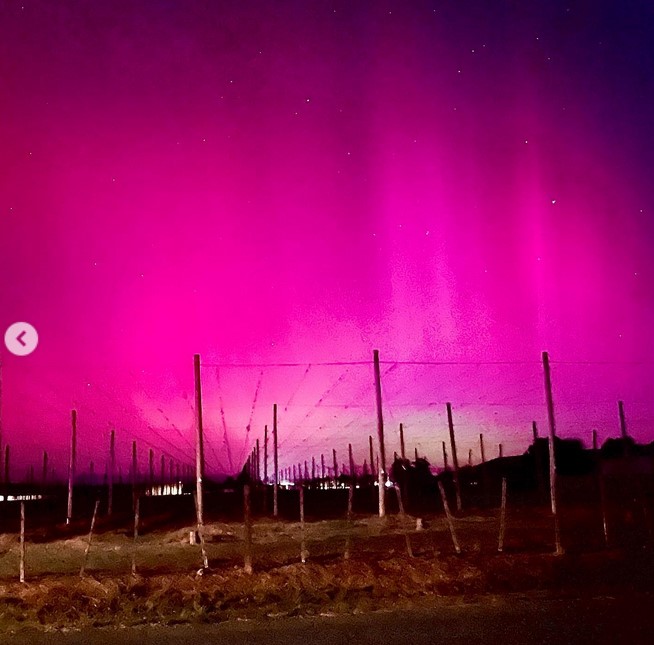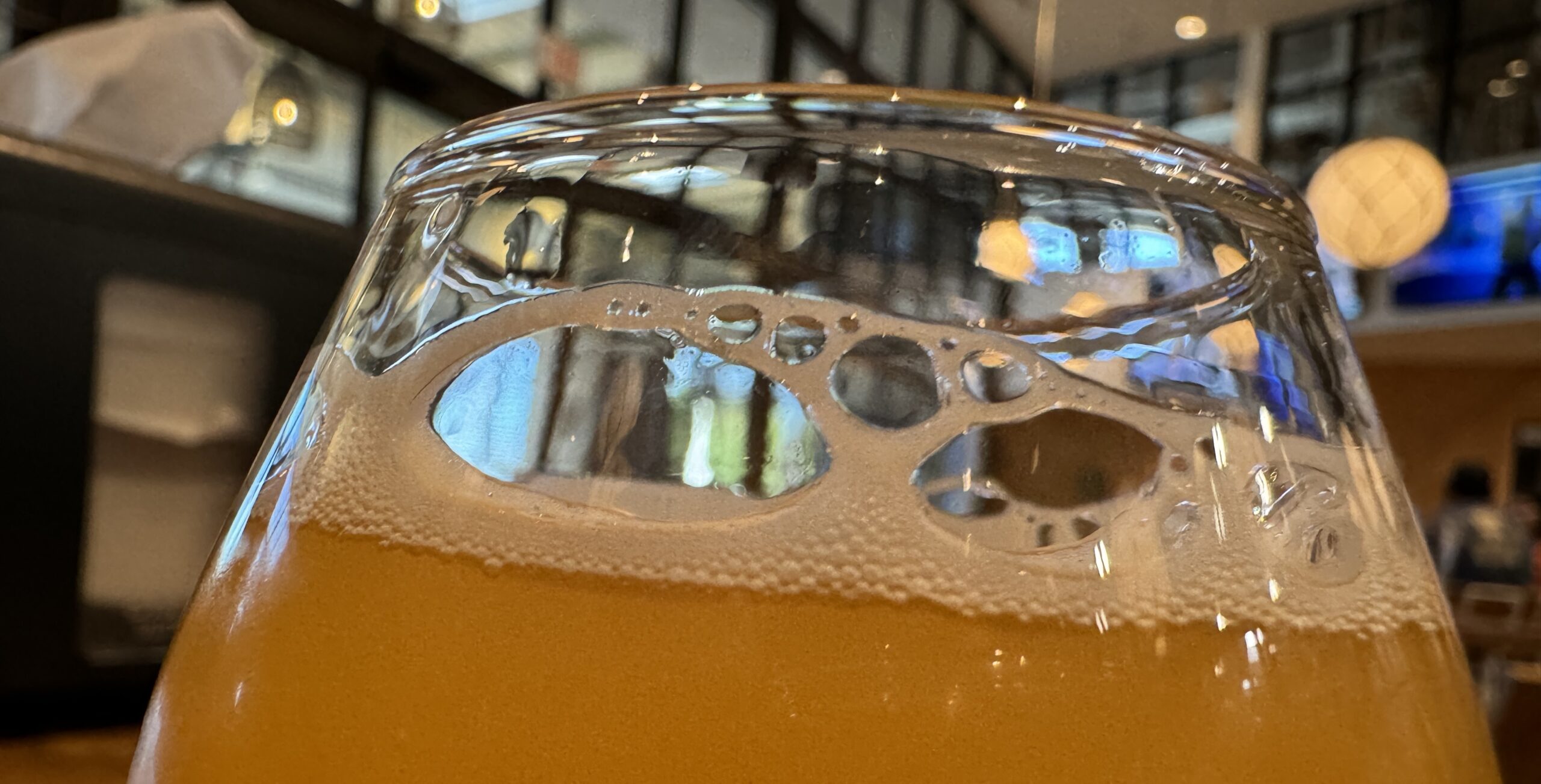* Resetting picking windows
* Region closeup: Australia
* Random observation
* Hop profile: Sterling
* Links
-Underrated, overrated hops
-German acreage
-Crosby recipe book

Welcome to Vol. 8, No. 1. Could there have been a better place to watch the Northern and Southern Lights that filled the skies last week than a hop yard? Not everybody would say yes, but I think it would have been grand to have been magically transported to this field at Mac Hops in New Zealand. Check out the Instagram post from Brent McGlashen. At CBC, he told a great story about snow and Nelson Sauvin that I need to flesh out and relay next month. This month’s regional closeup focuses on Australia. Next month, New Zealand.
HOP HEALTH AND AROMA
During a presentation at the Craft Brewers Conference, CLS Farms added another chapter to what could make a good book, focusing on hop picking windows and decision making that may impact aroma and flavor.
The newest wrinkle is the role hop stunt viroid may play in deciding when to pick Cascade. Research suggests that if recently planted virus-free Cascade fields are harvested on “traditional” harvest dates they will be picked “before their time.”
CLS marketing and sales manager Claire Demarais nicely summarized the presentation, “Exploring Hop Picking Windows and Their Impact on Aroma and Flavor,” at the company blog. She sat on the panel along with Alexandra Nowell (also CLS), John I. Haas sensory manager Jeff Dailey, and Tom Nielsen of Abstrax Hops.
You may download the 2024 presentation here, along with one from 2023 (presentations at CBC and the Master Brewers Association of the Americas convention were the same). The 2024 presentation builds on 2023, with more data and the discussion about picking adjustments farms may need to make when replacing Cascade infected by hop stunt viroid (HSVd) with virus-free Cascade.
There is much to consider. For instance:
* Dry-hopping beers with virus-free Cascade hops led to a decrease in 4MMP/4MSP composition but an increase in 3MH/3SH composition compared to those with virus-infected Cascade hops.
* Infected Cascade hops exhibited a higher level of 4MMP/4MSP compared to virus-free Cascade hops.
Of course, it is never that simple. That is why I urge you to spend time with the full presentations. Look beyond thiols for sensory data and other chemical analysis, as well as the importance of harvest timing for El Dorado.
At the end, there is advice about how to put the information to use:
* Differentiate between hops from virus-infected and virus-free yards; ask vendors about the origin of hops to provide context on possible aroma differences.
* Harvest dates impact hop aromas; request harvest dates for spot purchases to make informed decisions OR request harvest dates at or before selection.
* Recognize your personal preferences as a brewer regarding harvest windows and aroma profiles; provide feedback to vendors for better selection.
* Collaborate or discuss with other brewers on harvest window preference if participating in a group selection; tailor selections to match your recipe requirements.
REGION CLOSEUP: AUSTRALIA
Hop Products Australia harvested 26 percent fewer metric tons of hops in 2024 than in 2023. Much of that was intentional, taking into consideration that the worldwide supply of aroma hops is greater than demand. Production of Galaxy, which is 65 percent of what HPA sells, was down 20 percent to 879 metric tons. Vic Secret dipped 22 percent and Eclipse 57 percent.
Owen Johnston, head of sales and marketing, answered questions about the harvest and future plans via email.
Q: What were the factors that led to lower-than-expected yields this year?
A: There are a couple of factors that may have contributed to the lower-than-expected yields. Our Victorian farms experienced minor localized flooding that initially slowed plant growth and likely resulted in fewer flowering sites on the bines in those gardens. Both Victoria and Tasmania also experienced very mild summers. Without any really hot days at the tail-end of the growing season, some plants may not have reached their full potential in terms of cone size and gland fill.
Q: Can you elaborate on the decision making process that led to reducing acreage for 2024?
A: HPA is very conscious of the challenges our brewing customers are currently facing on a regular basis. It’s no secret many breweries have hops coming out their ears at the moment, whether it’s a hangover from the COVID pandemic or changing consumer tastes trending at odds with their long-term contracts.
Two of HPA’s strategic pillars are sustainability and quality, this means helping brewers work through their long positions so we can get back to a point where they are using fresh hops from the current crop year. It would be irresponsible for us to plant excess acreage that is dramatically different to the demand forecast from our brewing customers and international distribution partners.
Q: When will you decide about what and how much to string for 2025?
A: Forward contracts always underpin our decisions around how much of each variety we choose to string each season. However, some assumptions are required around the level of spot market demand that may eventuate for crop 2025. This can be a little tricky since we are trying to forecast demand as far out as February 2026, which will still be serviced by crop 2025. Decisions around changes to variety mix are typically made in November/December, with decisions around how much to string typically made in July/August.
Q: The press release mentions above average oil content. Are there other ways you can address the quality of the 2024 crop?
A: Crop 2024 will benefit from the introduction on key performance metrics on the number of bales in cold storage within four days, as well as 36 percent thicker foils to better preserve the volatile oil compounds in the final package. The Galaxy violin plots (also known as spider graphs or Rose charts) previously presented will be updated with crop 2024 results later this year, with the trend of increasing average oil content and reducing spread of oil content over time expected to hold true.
We have also been tightening our minimum quality standards over the past few years, conducting a sensory review of any material flagged as non-conforming at any stage of the production process. If subsequent data analysis reports a significantly lower alpha and oil content, or a significantly higher HSI this material is subject to assessment for potential faults and true-to-type aromas.
RANDOM OBSERVATION
This might be the beginning of a series, like Hop Profiles. It might be a one off. It might be something else.
Last month, Yakima Chief Hops gave a name, DynaBoost, to a flowable, whirlpool friendly product it had been calling YCH 702. I wrote about it for Brewing Industry Guide when it was still called 702. That is for subscribers only, so I will direct you to a YCH post that leans heavily into endorsements.
In it, Kelsey McNair at North Park Brewing says, “I’m a more is more is more kind of person when it comes to hops. With this product, I’ve found strategic advantages from a sensory perspective. We can use this in addition to what we are already doing to make beers that are mind-blowingly expressive. I really love the results.”
In the first chapter of “For the Love of Hops,” I wrote about why less can be more. I once asked for (and received) a “Less is More” T-shirt for Christmas. I am biased, and always happy to see brewers, cooks, whoever, strive to do more with less. But I acknowledge that North Park makes some beers that are very good at more.

And I also got to thinking about the two servings (this is one of them) of Pinthouse Cryogneic Electric Jellyfish I drank in April. The beer was made for Electric Jellyfish day, one of the riffs on the Austin brewery’s flagship IPA. It was brewed with six different cultivars, added at multiple times in the brewing process, and delivered in multiple forms. That included the thoroughly modern Simcoe 702 (now DynaBoost) and old-fashioned Chinook whole cones in the hopback.
All of those components might have resulted in something that tasted like HopMud™. Instead, it was the right kind of intense, with an aroma as fresh as what you smell in a freshly set kiln. It was one of the best beers I’ve had this year. I will leave it at that.
HOP PROFILE: STERLING
Sterling, bred in Oregon, has been considered a suitable replacement for Saazer-type hops since she was released in 1998. At the time, she was championed by Coors Brewing. The story is that after Anheuser-Busch brewed two batches with Sterling, August Busch III said, “Coors can keep this hop.”
Although smaller breweries are producing more lagers, and presumably looking for American aroma varieties with qualities similar to continental cultivars, production of Sterling continues to shrink. Farmers in Oregon harvested 56,000 pounds in 2023. It is hard for me to compare that production to most hops grown today. Let’s try this. In 2007, farmers in Oregon harvested 3.8 million pounds of Willamette (Washington farmers produced even more), most of which went to Aheuser-Busch. Last year, Oregon farmers harvested 669,000 pounds of Willamette. Which is a lot more than 56,000 pounds.
Heritage: Sterling originated from a cross made in 1990 between Saazer 38 (a USDA virus clonal selection from what is described as the original Czech Saazer hop) and USDA 21361M. The male resulted from a cross between Cascade and USDA 21136M. Sterling is 1/2 Saazer 38, 1/4 Cascade, 1/8 64035M (unknown German aroma x OP), 1/16 Brewer’s Gold, 1/32 Early Green, and 1/32 unknown.
The basics: 6-9% alpha acids, 4-6% beta acids, 1.3-1.9 mL/100 grams total oil. 11-17% of that oil will be farnesene, which is found in Saazer-type hops and adds floral character to aroma. In contrast, Citra and Cascade contain less than 1% farnesene.
Aroma qualities: Floral, grassy, herbal, citrus, spicy.
ELSEWHERE
– Listicle alert: The most underrated and overrated hops.
I wrote a story for the Craft Beer & Brewing IPA issue about brewing 21st century IPAs with 20th century hops. Granted, Cascade, Centennial and Chinook are all Top 10 hops (in acreage). But I would argue that all three, and particularly Chinook, are underappreciated.
– A report from Germany suggests acreage has not been reduced to the extent it has been in the United States. When the numbers are toted up, Perle and Hallertau Tradition will likely decline the most, while high alpha acreage will likely increase slightly.
– Crosby Hops is once again offering the recipes for beers brewed for the Craft Brewers Conference. In exchange, they want your email address.